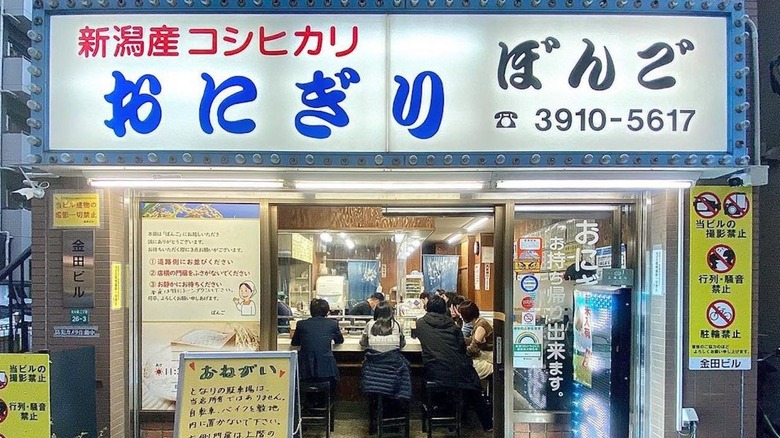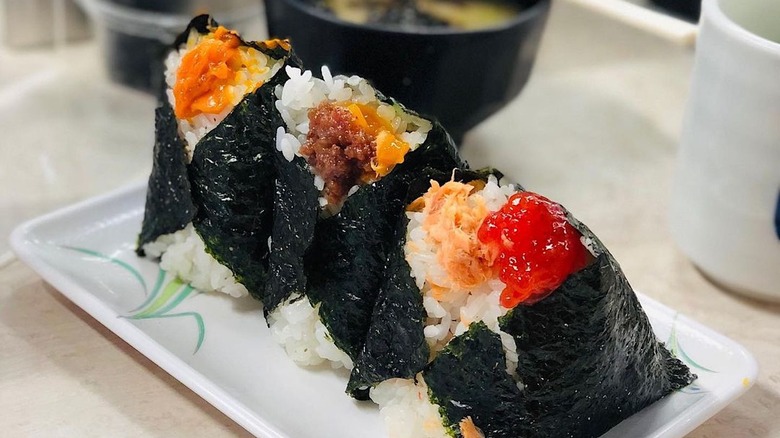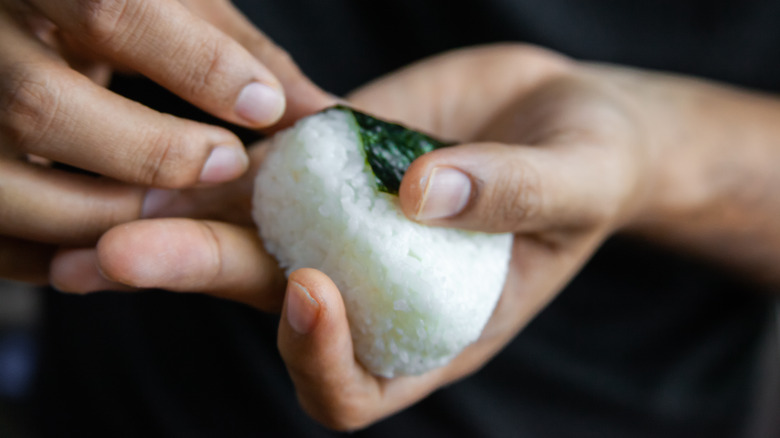The Top-Tier Onigiri That Justifies A 3-Hour Wait In Japan
From black truffle tacos to ice cream sundaes sprinkled with edible "diamonds," some foods are adored for their over-the-topness (via Lux Habitat). Yet others are appreciated for their humble simplicity, a certain rustic charm that conjures up a warm glow. One example is Japan's onigiri rice balls, often made at home from leftovers and stuffed into lunchboxes. A true soul food classic with ancient roots, its thought that Japanese people have been eating onigiri for more than 2,000 years (via Britannica). And they are so beloved that they're even swapped as gifts.
Despite its simplicity, this rice snack can be an art form in itself, with onigiri masters bringing their own unique vision into the mix. In essence, an onigiri is salted sushi rice shaped into triangles or cylinders, stuffed with filling, and wrapped in nori (dried seaweed). Traditional fillings are salmon, tuna, cod roe, dried kelp, pickled radish, pickled plum, and tofu, but the options and combos are endless (via Chef Ja Cooks).
According to the The Creative Adventurer, Japanese people can have strong nostalgic associations with this comfort food, as it's the snack of picnics, countryside hikes, and the annual school sports festival, Undokai. Yet over 1,000 years ago, onigiri was actually an elite dish of the Japanese royal family, who ate it at banquets. And nowadays, there are whole restaurants devoted to these unassuming rice balls — and one in particular has customers happily lining up for hours.
The Tokyo onigiri restaurant that attracts crowds
People usually need a compelling reason to wait in a lengthy line. Whether it's buying the latest iPhone, bidding farewell to a monarch, or (once upon a time) trying out a cronut, there has to be a pretty strong incentive to put your feet through so much punishment. And yet in Tokyo, long queues can routinely snake outside of Onigiri Bongo, a 60-year-old restaurant where customers can wait for three to five hours to try out the menu (via NPR).
This modest nine-seater eating spot has a homespun, unpretentious vibe and is overseen by Onigiri Master, Yumiko Ukon. Customers sit huddled around the counter, watching the kitchen staff at work while enjoying their onigiri with miso soup, tea, and pickles (via GPB News). One big pull is the generous size of each onigiri, which probably won't leave you hungry. But another is the sheer breadth of the menu, offering 55 types in total. As explained by NPR, over the years, Yumiko has challenged the idea of the "typical" rice ball, resulting in quite a few surprises.
Why Yumiko Ukon is a master at her craft
For instance, the restaurant has kept up with the times, catering to the preferences of younger customers and tourists by introducing fillings like meat or mayo. So while you still get classics like pickled plum with salmon roe, you can also order curry with beef, bacon with cheese, fried chicken, pork kimchi, and peperoncino.
Then, there are Yumiko's considerable skills, honed over 35 years. According to Eater, she makes around 1,500 onigiri a day by hand, meaning up to 500,000 a year and over 17 million over her entire career. As you'd expect, she has perfected her craft, whipping up each ball in seconds. And she has mastered the art of squeezing each one with just the right amount of pressure, so that the rice stays fluffy, the onigiri holds together, and the whole thing crumbles beautifully in your mouth (via The Smart Local). And her inspiration? As told to Eater, it is her mother, who never bought onigiri from stores and always made it by hand.
So if you ever find yourself in Tokyo with a few hours to spare, it might be well worth waiting in line for this lovingly assembled snack.


